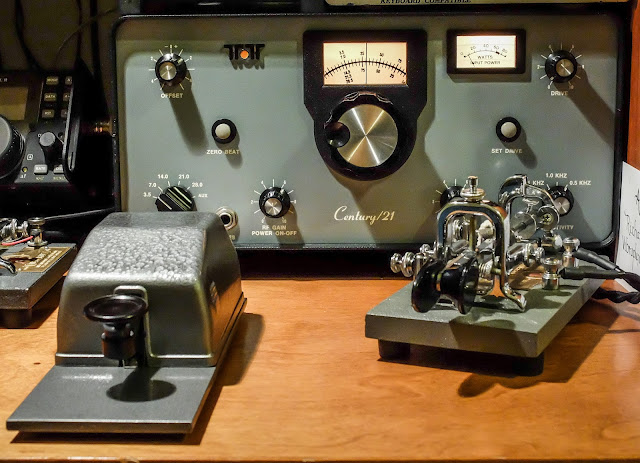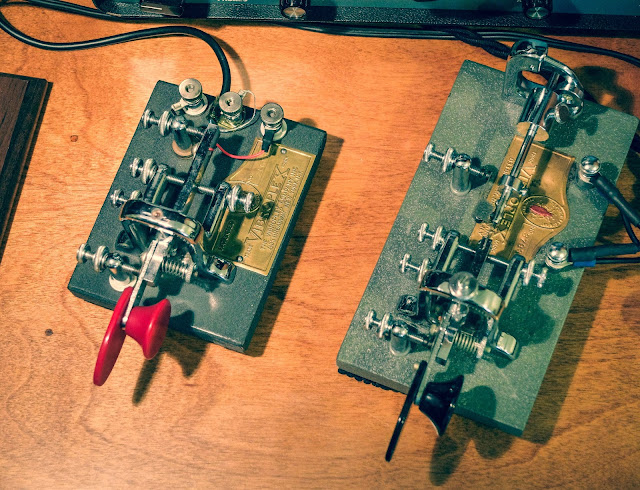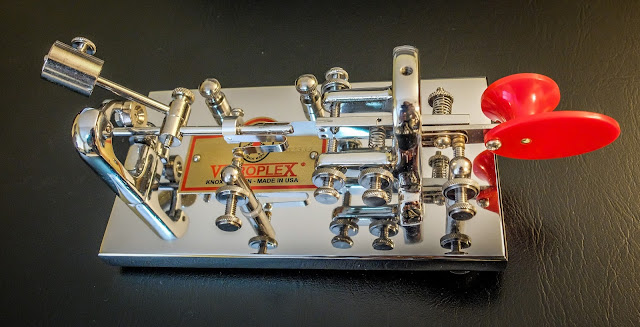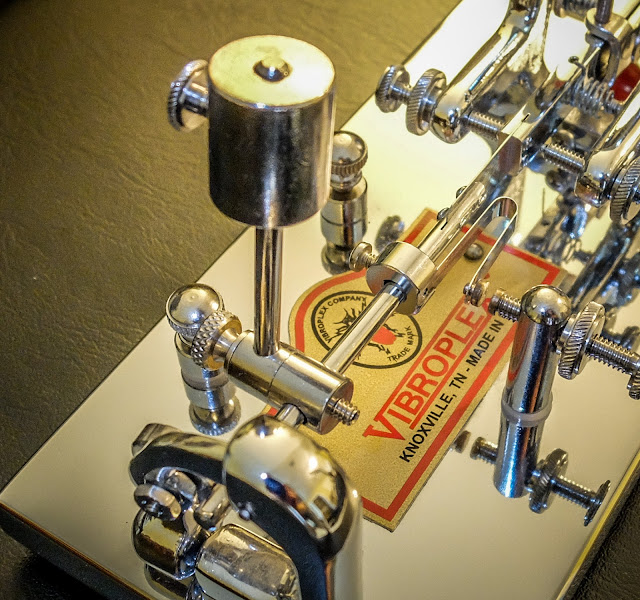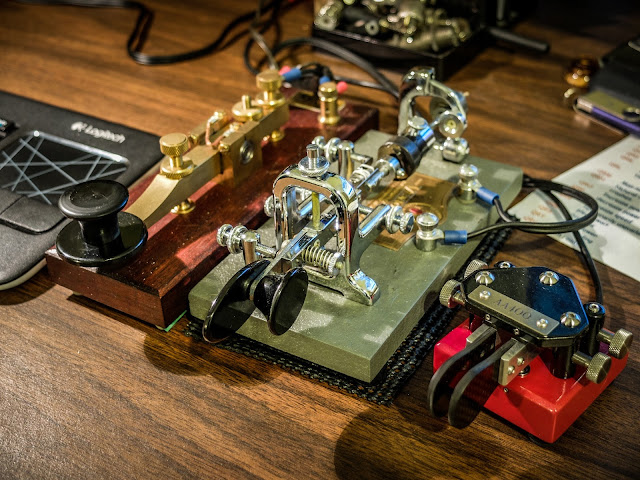The Perfect Bug?
In the Western World we are consumers. Advertising drives us to think we'd be a bit happier if we had that new "thing", whatever the thing is. It drives much of our economies and unfortunately keeps many burdened in debt.
That's certainly a pessimistic way to begin this but let's be honest. No one needs a ~$580 morse code key. Most of us are handy enough to make a straight key out of stuff laying around the house for free. I have a number of very fine keys that I've purchased used. I've purchased most of them for well under $70, including my 1970s Standard Vibroplex Bug.
So... having a key that is easy to operate; a key that disappears under your hand is an enjoyable thing.
Operating a Bug correctly, or more precisely in a manner that is pleasing to the person copying your code is more difficult than operating paddles with an electronic keyer. When the bug was invented it was a tool used by professional telegraphers. There were no electronic keyers, and having a tool that allowed them to send good code for hours on end with less mechanical stress on their bodies than a straight key was important, and they sought the best tool they could afford to allow them to do their work.
But no one reading this is a professional telegrapher, because that ship has sailed.
For those of us that choose to use a Bug, we do so for different reasons. For me, I enjoy the control I have in forming my characters, as well as the extra level of difficulty in sending good code. Why would I want it to be more difficult? Well, why do we do anything that is challenging. Being challenged is fun. It drives me to improve. It takes my mind off of things that might otherwise crowd my thoughts if I were not doing something challenging that is also fun.
I have operated a bunch of different bugs at my club gettogethers, from different makers. They all have a different feel. They all intrigue or annoy their user. I have two Vibroplex Bugs at my station. I've previously written about them. They each have advantages and challenges but they share the same design and they have more in common than they do differences.
A New Design
Fortunately for amateur radio operators there are still new keys being developed, and in this case a new design for a semi-automatic key that has a markedly different design from most of the bugs that came before.
The Begali Intrepid is distinctive in a few ways:
- The pendulum hinge is at the rear of the key rather than the middle
- The adjustments are all based on magnets rather than springs
- The dwell for the dits has a real control, rather than using various pieces of foam, string or clips to change dwell time
- The dit contact is a sprung plunger that always remains centered on the contact rather than brushing against it at various angles
- The split lever mechanism operates at the center of the key placing the DAH and DIT contacts much closer to one another than a traditional bug
- There is less mass in the pendulum itself than a Vibroplex Bug
- It has a sprung, nylon wheel damper that doesn't clatter
- It weighs a TON (well about 6 lbs) and feels welded to the desk without having to use non-slip material or using spit to semi glue them in place (yech, yes I use spit to hold my keys to my desk)
I've not had the chance to try the GHD fully automatic bugs, nor their bugs that use optical contacts. That would be interesting, but they still fundamentally follow the Vibroplex model.
You'll notice there are spare holes. I assume they are to allow the frame to be used for left handed operation.
Preparing for Use
The Intrepid ships with a cable but there's nothing to plug it into on the key. It's up to the owner to solder the connections. I understand that some transceivers require different plug wiring but in general they are fairly common. Be prepared to spend some time soldering under the key to wire it up.
I had some spare 1/8" plugs for projects, and with some heat shrink tubing and a couple pieces of wire I created a tidy connector for the male to male cable shipped with the key.
In Use
I spent about 2 hours practice sending into the practice oscillator that I built. I had a Vibroplex Deluxe Bug next to it that I alternated with. The range of DIT speeds on the Intrepid is impressive. Other makers like Vizkey have created bugs with a similar range of adjustment, and the Deluxe Bug I use has a Vari-Speed that can match the Intrepids speed range, bu the Intrepid is easier to quickly adjust and more importantly can be done one-handed. It will comfortably go from about 15 wpm up to 35 wpm and with the dwell adjustment makes changing speeds and keeping the DIT dwell correct, is singular. I don't think any bug can match it in that respect.
It did require a change in how I operate. The Vibroplex Bug fingerpieces stick out further and I have the habit of placing my index finger out over the top of the Bug. The Intrepid doesn't allow for that. I have to curl my index finger down to avoid hitting the bracing for the pendulum.
Because there is less mass in the pendulum it operates with a much lighter touch than Vibroplex Bug. The pendulm movement is initated with less force and due to the isolation of the pendulum from the paddles you don't feel the pendulum moving as you do with a Vibroplex. I kinda like the feedback I get from Vibroplex pendulum. The Intrepid feels more like a single paddle key with an electronic keyer than a bug.
Because of the how the lever is split in the middle, the actual DAH contact is almost dead center in the key rather than toward the front. It is far closer to the DIT contact than a bug. I have no way to describe it other than to say it feels as if the DAH and DIT operations are more similar than they are different.
I tend to pivot at my wrist when I operate a Vibroplex bug, to control the timing of DIT to DAH transitions. That doesn't seem to be as necessary with the Intrepid. Again, it feels more like a paddle than a Bug.
The DIT contact is a sprung plunger that is always centered. This is one of the biggest problem areas on a Vibroplex Bug and Begali has masterfully designed the proper contact. Most Bug operators spend more time adjusting the U-spring to try and get proper contact than any other part of the key. I assume this level of precision is just not something that Vibroplex wanted to spend the time on in manufacturing.
The sprung teflon damper makes for clatter free operation. No more ker-thunk as you transition from DITS to DAHS. They key is markedly quieter in operation than any other Bug I've tried. The only other key that comes close is the right-angle Vizkey.
Conclusions?
This is a very fine piece of engineering. It will take me months to decide if stick with it over a Vibroplex Bug, but for now I'm thinking it was a fine birthday gift.
That's all for now
So lower your power and raise your expectations.
Rich, AA4OO https://hamradioqrp.com


















